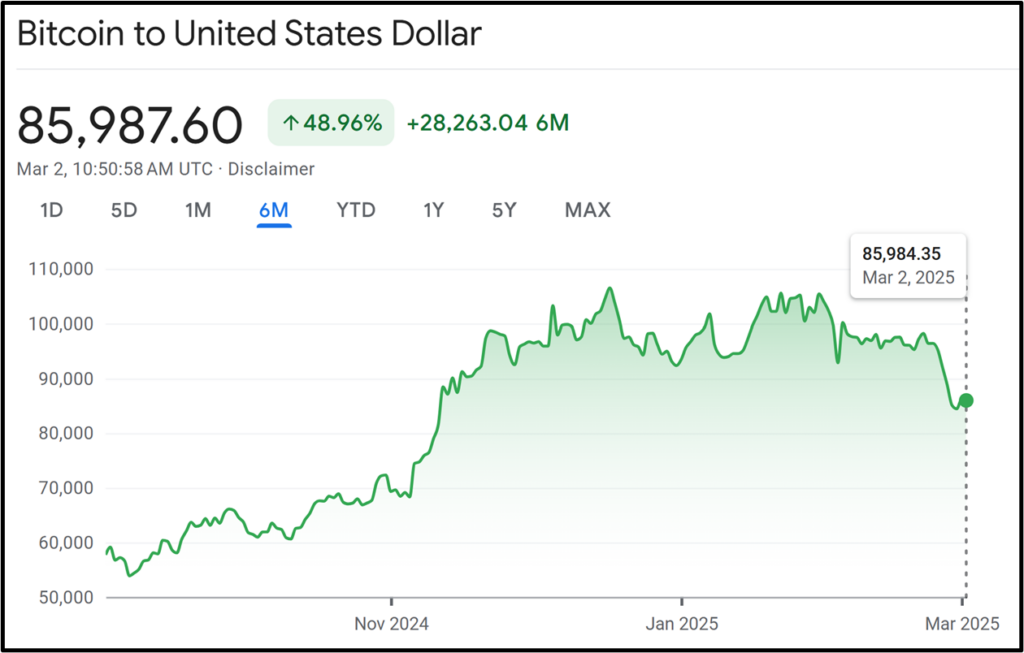Bitcoin’s Wild Ride Continues

Bitcoin stands at a crossroads, caught between being a revolutionary financial asset and mounting scepticism over its long-term viability. Once hailed the future of decentralised finance, the cryptocurrency now faces growing regulatory scrutiny, volatile price swings and questions about its intrinsic value. As institutions cautiously engage and governments tighten oversight, the debate over Bitcoin’s true role in the financial system has never been more urgent
Bitcoin has seen staggering price swings since its inception, with its latest resurgence prompting renewed enthusiasm from both Wall Street and Main Street. Its price, recently breaching the $100,000-mark for the first time, is up about 50% compared to six months ago, yet down nearly 8% from the start of this year.

Image: Bitcoin price in USD; Source: Google Finance
Recent research from Capital Economics, an independent UK-based economics think-tank, argues that this resurgence may be built on shaky foundations, driven more by speculation than intrinsic value. While proponents claim Bitcoin is ‘digital gold’ – a hedge against inflation and monetary instability – research challenges this notion, citing historical price movements that fail to align with traditional safe-haven assets like gold or government bonds.
Bitcoin instead has high correlation with risky assets, especially equities. While many hoped it would serve as a shield against inflation, its value plunged in tandem with stock markets during global economic turmoil. This raises doubts about its ability to function as a store of value in crises.
The past few years have seen a wave of institutional adoption, with hedge funds, corporations, and even governments dabbling in Bitcoin. The launch of Bitcoin ETFs in major financial markets was heralded as a turning point, legitimising the asset. However, experts remain sceptical about whether this institutional embrace is truly transformative or merely another speculative cycle.
The research highlights a key challenge: Bitcoin lacks fundamental value drivers. Unlike stocks, which generate earnings, or bonds, which provide yields, Bitcoin’s value is largely dictated by sentiment and network effects. This creates an environment prone to sharp price swings, making it a risky proposition for long-term investment portfolios.
Another major hurdle facing Bitcoin is regulatory scrutiny. Governments worldwide are tightening oversight on digital assets, citing concerns over money laundering, tax evasion, and financial stability risks. Experts warn increased regulation could stifle Bitcoin’s appeal, particularly among institutional investors who require regulatory clarity before committing significant capital.
China’s crackdown on Bitcoin mining and the U.S. Securities and Exchange Commission’s (SEC) cautious stance on crypto-related financial products underscore the challenges ahead.If regulatory pressures mount, Bitcoin’s ability to function as a decentralised financial instrument could be severely undermined.
Latest policy shifts under U.S. President Donald Trump’s administration have added further uncertainty. The White House has signalled a more interventionist stance on cryptocurrency regulation, emphasising stricter Know Your Customer (KYC) and Anti-Money Laundering (AML) measures. The administration has also floated the possibility of increased taxation on crypto transactions, a move that could dampen speculative trading.
Meanwhile, ongoing congressional debates about the status of stablecoins and central bank digital currencies (CBDCs) suggest that Bitcoin’s regulatory environment remains in flux. These developments could determine whether Bitcoin remains a thriving digital asset or faces a harsher regulatory crackdown in the U.S., one of its most important markets.
While Bitcoin remains the flagship cryptocurrency, the broader crypto market has evolved significantly. Ethereum, Solana, and other blockchain-based networks are developing use cases that extend beyond simple store-of-value narratives. The rise of decentralised finance (DeFi) and non-fungible tokens (NFTs) suggest blockchain technology may have staying power even if Bitcoin’s dominance wanes.
The crucial question is whether Bitcoin is a revolutionary technology or simply the first iteration of a digital asset boom that will eventually be overshadowed by more efficient alternatives? Some analysts argue Bitcoin’s energy-intensive proof-of-work system makes it outdated compared to newer blockchain solutions.
Capital Economics’ analysis ultimately paints a picture of uncertainty. While Bitcoin has defied sceptics time and again, its long-term viability as a mainstream financial asset remains unproven. As central banks develop digital currencies and regulatory pressures intensify, Bitcoin’s role in the financial system could face significant challenges.
For business leaders and investors, the key takeaway is caution. While the allure is undeniable, its fundamental risks cannot be ignored. Whether it remains a volatile plaything for speculators or matures into a legitimate asset class will depend on technological, regulatory, and macroeconomic developments in the years to come. As the debate rages on, one thing is certain – Bitcoin’s story is far from over.


